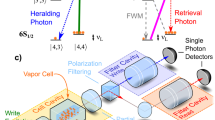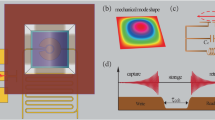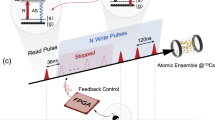Abstract
Storing and retrieving a quantum state of light on demand, without corrupting the information it carries, is an important challenge in the field of quantum information processing. Classical measurement and reconstruction strategies for storing light must necessarily destroy quantum information as a consequence of the Heisenberg uncertainty principle. There has been significant effort directed towards the development of devices—so-called quantum memories—capable of avoiding this penalty. So far, successful demonstrations1,2,3,4,5,6 of non-classical storage and on-demand recall have used atomic vapours and have been limited to low efficiencies, of less than 17 per cent, using weak quantum states with an average photon number of around one. Here we report a low-noise, highly efficient (up to 69 per cent) quantum memory for light that uses a solid-state medium. The device allows the storage and recall of light more faithfully than is possible using a classical memory, for weak coherent states at the single-photon level through to bright states of up to 500 photons. For input coherent states containing on average 30 photons or fewer, the performance exceeded the no-cloning limit. This guaranteed that more information about the inputs was retrieved from the memory than was left behind or destroyed, a feature that will provide security in communications applications.
This is a preview of subscription content, access via your institution
Access options
Subscribe to this journal
Receive 51 print issues and online access
$199.00 per year
only $3.90 per issue
Buy this article
- Purchase on Springer Link
- Instant access to full article PDF
Prices may be subject to local taxes which are calculated during checkout



Similar content being viewed by others
References
Appel, J., Figueroa, E., Korystov, D., Lobino, M. & Lvovsky, A. Quantum memory for squeezed light. Phys. Rev. Lett. 100, 093602 (2008)
Chanelière, T. et al. Storage and retrieval of single photons transmitted between remote quantum memories. Nature 438, 833–836 (2005)
Lobino, M., Kupchak, C., Figueroa, E. & Lvovsky, A. I. Memory for light as a quantum process. Phys. Rev. Lett. 102, 203601 (2009)
Eisaman, M. D. et al. Electromagnetically induced transparency with tunable single-photon pulses. Nature 438, 837–841 (2005)
Choi, K., Deng, H., Laurat, J. & Kimble, H. Mapping photonic entanglement into and out of a quantum memory. Nature 452, 67–71 (2008)
Honda, K. et al. Storage and retrieval of a squeezed vacuum. Phys. Rev. Lett. 100, 093601 (2008)
Julsgaard, B., Sherson, J., Cirac, J. I., Fiurásek, J. & Polzik, E. S. Experimental demonstration of quantum memory for light. Nature 432, 482–486 (2004)
de Riedmatten, H., Afzelius, M., Staudt, M. U., Simon, C. & Gisin, N. A solid-state light-matter interface at the single-photon level. Nature 456, 773–777 (2008)
Sangouard, N., Simon, C., Riedmatten, H. D. & Gisin, N. Quantum repeaters based on atomic ensembles and linear optics. Preprint at 〈http://arxiv.org/abs/0906.2699〉 (2009)
Grosshans, F. & Grangier, P. Quantum cloning and teleportation criteria for continuous quantum variables. Phys. Rev. A 64, 010301 (2001)
Varnava, M., Browne, D. & Rudolph, T. Loss tolerance in one-way quantum computation via counterfactual error correction. Phys. Rev. Lett. 97, 120501 (2006)
Hau, L., Harris, S., Dutton, Z. & Behroozi, C. Light speed reduction to 17 metres per second in an ultracold atomic gas. Nature 397, 594–598 (1999)
Nunn, J. et al. Mapping broadband single-photon wave packets into an atomic memory. Phys. Rev. A 75, 011401 (2007)
Hétet, G., Longdell, J. J., Alexander, A. L., Lam, P. K. & Sellars, M. J. Electro-optic quantum memory for light using two-level atoms. Phys. Rev. Lett. 100, 023601 (2008)
Novikova, I., Phillips, N. & Gorshkov, A. Optimal light storage with full pulse-shape control. Phys. Rev. A 78, 021802 (2008)
Tittel, W. et al. Photon-echo quantum memory in solid state systems. Laser Photon. Rev. 4, 244–267 (2009)
Böttger, T., Thiel, C., Cone, R. & Sun, Y. Effects of magnetic field orientation on optical decoherence in Er3+:Y2SiO5 . Phys. Rev. B 79, 115104 (2009)
Longdell, J., Fraval, E., Sellars, M. & Manson, N. Stopped light with storage times greater than one second using electromagnetically induced transparency in a solid. Phys. Rev. Lett. 95, 063601 (2005)
Sun, Y. Recent progress in developing new rare earth materials for hole burning and coherent transient applications. J. Lumin. 98, 281–287 (2002)
Alexander, A. L., Longdell, J. J., Sellars, M. J. & Manson, N. B. Photon echoes produced by switching electric fields. Phys. Rev. Lett. 96, 043602 (2006)
Kraus, B. et al. Quantum memory for nonstationary light fields based on controlled reversible inhomogeneous broadening. Phys. Rev. A 73, 020302 (2006)
Alexander, A. L. Investigation of Quantum Information Storage in Rare Earth Doped Materials. PhD thesis, Australian National Univ. (2007)
Hétet, G. et al. Photon echoes generated by reversing magnetic field gradients in a rubidium vapor. Opt. Lett. 33, 2323–2325 (2008)
Lauritzen, B. et al. Telecommunication-wavelength solid-state memory at the single photon level. Phys. Rev. Lett. 104, 080502 (2010)
Ahlefeldt, R. L., Smith, A. & Sellars, M. J. Ligand isotope structure of the optical 7F0→5D0 transition in EuCl3·6H2O. Phys. Rev. B 80, 205106 (2009)
Afzelius, M., Simon, C., de Riedmatten, H. & Gisin, N. Multimode quantum memory based on atomic frequency combs. Phys. Rev. A 79, 052329 (2009)
Hosseini, M. et al. Coherent optical pulse sequencer for quantum applications. Nature 461, 241–245 (2009)
Longdell, J., Hétet, G., Lam, P. & Sellars, M. Analytic treatment of controlled reversible inhomogeneous broadening quantum memories for light using two-level atoms. Phys. Rev. A 78, 1–6 (2008)
Walls, D. & Milburn, G. Quantum Optics 20, 21 (Springer, 1994)
Haario, H., Saksman, E. & Tamminen, J. An adaptive Metropolis algorithm. Bernoulli 7, 223–242 (2001)
Longdell, J., Alexander, A. & Sellars, M. Characterization of the hyperfine interaction in europium-doped yttrium orthosilicate and europium chloride hexahydrate. Phys. Rev. B 74, 195101 (2006)
Acknowledgements
The authors gratefully acknowledge S. Beavan, R. Ahlefeldt and J. Bartholomew for proofreading the manuscript. M.J.S. was supported by the Australian Research Council. J.J.L. was supported by a New Economy Research Fund grant from the New Zealand Foundation for Research Science and Technology
Author information
Authors and Affiliations
Contributions
The initial project was conceived by M.J.S. and J.J.L. Various preliminary experiments were conducted by M.P.H. with assistance and guidance from M.J.S., J.J.L. and Y.L. The final experiment was designed, built and conducted by M.P.H. under the guidance of M.J.S. Data was analysed by M.P.H. with assistance in interpretation by M.J.S. and J.J.L. Theoretical modelling was done by M.P.H., building on work of J.J.L. Supplementary noise theory was prepared by M.P.H. with assistance from J.J.L. and comments from Y.L. The manuscript was prepared by M.P.H., M.J.S. and J.J.L.
Corresponding author
Ethics declarations
Competing interests
The authors declare no competing financial interests.
Supplementary information
Supplementary Information
This file contains Supplementary Methods and Data and References. (PDF 80 kb)
Rights and permissions
About this article
Cite this article
Hedges, M., Longdell, J., Li, Y. et al. Efficient quantum memory for light. Nature 465, 1052–1056 (2010). https://doi.org/10.1038/nature09081
Received:
Accepted:
Issue Date:
DOI: https://doi.org/10.1038/nature09081
This article is cited by
-
Quantum storage of entangled photons at telecom wavelengths in a crystal
Nature Communications (2023)
-
Fast, noise-free atomic optical memory with 35-percent end-to-end efficiency
Communications Physics (2023)
-
Rare-earth quantum memories: The experimental status quo
Frontiers of Physics (2023)
-
Storage of photonic time-bin qubits for up to 20 ms in a rare-earth doped crystal
npj Quantum Information (2022)
-
Long-range cooperative resonances in rare-earth ion arrays inside photonic resonators
Communications Physics (2022)
Comments
By submitting a comment you agree to abide by our Terms and Community Guidelines. If you find something abusive or that does not comply with our terms or guidelines please flag it as inappropriate.



